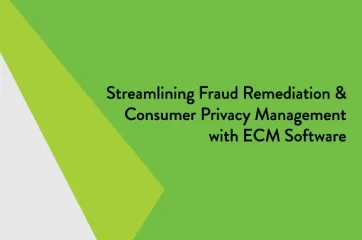Document Management in Banking
Document management in banking includes all the systems and processes that are necessary to collect, organize, and track any information that relates to customers, members, accounts, and operations.
Document management is the backbone of every financial institution. It’s also such an ingrained part of a banker’s daily experience that the “management” portion may not always get the sharp focus it deserves. Let’s take a closer look.
Collect, Organize, Recall, Purge
At a basic level, document management in banking involves collecting all necessary initial signatory requirements—both electronic and wet signatures—and having them easily accessible. However, that is just the beginning of the process.
Beyond keeping track of this documentation, files must be tracked and retained for a period of time—even after accounts close. Financial institutions must also have systems in place to efficiently identify records to purge and destroy based on their retention schedules.
Customer, Member & Account Document Management
By their nature, customer and member accounts require varying levels of documentation. Some accounts that seem relatively simple, such as personal savings and checking accounts, can go well beyond a signature card and include documentation of items such as marriage and death certificates.
Residential mortgages are even more demanding; banks and credit unions must find an effective means of tracking, storing, and accessing an entire gamut of records, from closing, servicing, and pay-off documents to collection, foreclosure, and bankruptcy files.
A financial institution’s trust department can be heavily invested in document management. Bankers handling these accounts are often charged with maintaining power of attorney and conservatorship papers along with records of a client’s investment portfolios, banking records, and bill payments.
Managing this myriad assortment in an organized way is imperative.
Don’t Forget the Back Office
Not only do all these accounts need to be carefully documented, but so do the bank or credit union’s records as a business entity itself. Among the many items that need to be tracked are wire transfers, BSA monitoring, SARs, and CTRs. Other examples include daily non-post items and reviews of overdrafts as well as accounts payable transactions.
Document Management in Banking is Vital
The conclusion is simple: for a bank or credit union, superior document management is crucial. Excellent customer and member service, smooth audits, and overall efficiency depend on it.
Additional Resources
For more tips about document management in banking, be sure to check out our extensive resource library with free document tracking spreadsheets, whitepapers, and eBooks.
Looking for more banking definitions? Check out our banking definitions page.














